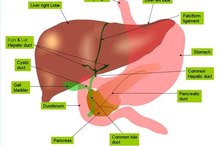How Is Glucose Produced?
Your body thrives on glucose, which is the sugar it uses to synthesize energy. Carbohydrates supply glucose and other sugars that are converted into glucose. But it's such a vital source of energy that the body has a back-up system called gluconeogenesis. This metabolic pathway produces new glucose from noncarbohydrate sources.
Glucose Generation From Carbs
Carbohydrates are made from molecules of sugar connected together. Simple sugars consist of one to three sugar molecules, while starches contain hundreds to thousands of molecules, reports Colorado State University.
The small intestine only absorbs single sugar molecules, which is why digestive enzymes break carbs down into the three monosaccharides: glucose, galactose and fructose. The monosaccharides travel to the liver, where glucose is generated when the liver turns galactose and fructose into glucose.
The liver may send glucose into the bloodstream, where it’s transported to cells that need it for energy. If blood levels of glucose are high enough to meet your energy needs, the liver stores glucose by turning it into glycogen or fat.
New Glucose Synthesis
Is Glucose Stored in the Human Body?
Learn More
When the body produces glucose from something other than carbohydrates, the process is called gluconeogenesis. Most gluconeogenesis occurs in the liver, but a small amount also takes place in the kidneys and small intestine.
Like carbs, fats and proteins are digested into smaller units. Glycerol from fats and amino acids from proteins may be used to make glucose. All amino acids except leucine and lysine can enter the gluconeogenesis pathway, but glutamine is the only one used in the kidneys and small intestine, according to Medical Biochemistry Page.
Lactate is another substance used to synthesize new glucose. The boost in energy metabolism during intense exercise results in the production of lactate. Some of it travels through the bloodstream to the liver, where it's converted into glucose.
Nutritional Support
Glucose production relies on a variety of nutrients, but biotin is one of the most important for gluconeogenesis. Biotin is needed to make the enzyme that triggers the first step of gluconeogenesis in the liver.
Three other B vitamins -- thiamin, pantothenic acid and vitamin B-6 -- are also essential. Thiamin and pantothenic acid help synthesize acetyl-coenzyme A, which has a significant role in gluconeogenesis. Vitamin B-6 is used to make an enzyme needed to turn amino acids into glucose.
Sources of Vitamins
What Does the Liver Do With Amino Acids?
Learn More
Eating a balanced diet is always the best way to get nutrients. That’s especially true when it comes to supporting gluconeogenesis because the B vitamins come from different sources.
Pork, fish, beef, chicken, eggs and whole grains are good sources of thiamin, biotin and pantothenic acid. You’ll also get thiamin from beans, squash and sunflower seeds. The best choices for vitamin B-6 include chicken, salmon, potatoes, spinach and bananas.
In supplemental form, thiamin, biotin and pantothenic acid are considered safe and not likely to cause any side effects. Vitamin B-6 supplements may cause pain and numbness in the arms and legs, but it takes at least 200 times more than the normal recommended intake to cause side effects, according to the Linus Pauling Institute.
Related Articles
References
- Colorado State University: Absorption of Monosaccharides
- Colorado State University: Dietary Polysaccharides: Structure and Digestion
- Medical Biochemistry Page: Gluconeogenesis: Endogenous Glucose Synthesis
- University of Wisconsin: Biotin Function
- Linus Pauling Institute: Vitamin B6
- Office of Dietary Supplements: Thiamin
- Linus Pauling Institute: Pantothenic Acid
- Linus Pauling Institute: Biotin
Writer Bio
Sandi Busch received a Bachelor of Arts in psychology, then pursued training in nursing and nutrition. She taught families to plan and prepare special diets, worked as a therapeutic support specialist, and now writes about her favorite topics – nutrition, food, families and parenting – for hospitals and trade magazines.









